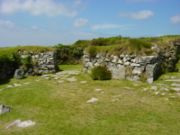
Chysauster Ancient Village
Encyclopedia

Iron Age
The Iron Age is the archaeological period generally occurring after the Bronze Age, marked by the prevalent use of iron. The early period of the age is characterized by the widespread use of iron or steel. The adoption of such material coincided with other changes in society, including differing...
and Romano-British
Romano-British
Romano-British culture describes the culture that arose in Britain under the Roman Empire following the Roman conquest of AD 43 and the creation of the province of Britannia. It arose as a fusion of the imported Roman culture with that of the indigenous Britons, a people of Celtic language and...
village of courtyard house
Courtyard house
A courtyard house is a type of house — often a large house — where the main part of the building is disposed around a central courtyard. Many houses that have courtyards are not courtyard houses of the type covered by this article. For example, large houses often have small courtyards surrounded by...
s in Cornwall
Cornwall
Cornwall is a unitary authority and ceremonial county of England, within the United Kingdom. It is bordered to the north and west by the Celtic Sea, to the south by the English Channel, and to the east by the county of Devon, over the River Tamar. Cornwall has a population of , and covers an area of...
, England, United Kingdom
United Kingdom
The United Kingdom of Great Britain and Northern IrelandIn the United Kingdom and Dependencies, other languages have been officially recognised as legitimate autochthonous languages under the European Charter for Regional or Minority Languages...
, which is currently in the care of English Heritage
English Heritage
English Heritage . is an executive non-departmental public body of the British Government sponsored by the Department for Culture, Media and Sport...
. To the south east is the remains of a fogou
Fogou
A fogou or fougou is an underground, dry-stone structure found on Iron Age or Romano-British defended settlement sites in Cornwall. Fogous have similarities with souterrains or earth-houses of northern Europe and particularly Scotland including the Orkney Islands...
, an underground structure of uncertain function.
The village was believed to have been constructed and occupied between 100 BC and 400 AD; it was primarily agricultural and unfortified and probably occupied by members of the Dumnonii
Dumnonii
The Dumnonii or Dumnones were a British Celtic tribe who inhabited Dumnonia, the area now known as Devon and Cornwall in the farther parts of the South West peninsula of Britain, from at least the Iron Age up to the early Saxon period...
tribe.
The village included eight stone dwellings, arranged in pairs along a street, each with its own garden plot. The houses are oval shaped and around 28 metres long. Their walls survive to heights of up to 3 metres. Small chambers lead off from the main courtyards of each house which served as working and living areas. A field system in the vicinity attests to the site's farming connections. The nearby hill fort
Hill fort
A hill fort is a type of earthworks used as a fortified refuge or defended settlement, located to exploit a rise in elevation for defensive advantage. They are typically European and of the Bronze and Iron Ages. Some were used in the post-Roman period...
of Castle An Dinas may have been a contemporary refuge for the occupants of the village in times of strife.
It has been excavated on many occasions, and some of the reinstatement work which has been carried out over the years has been unsympathetic. Several sections of the village were incorrectly reinstated in the wake of previous excavations.
Controversy over the site
The fogou nearby was filled in by English Heritage in the 1980s in an attempt to prevent it from caving in, a move which was unpopular with the local community. In the 1990s, archaeologist Craig WeatherhillCraig Weatherhill
Craig Weatherhill is a Cornish author both of fiction and non-fiction works about Cornwall.-Biography:Raised in St Just in Penwith and then in Falmouth, after serving in the forces he developed a career in conservation and architecture. In his younger days, the 6' 3" Weatherhill was a goalkeeper,...
questioned the then head of English Heritage, Lord Montagu
Edward Douglas-Scott-Montagu, 3rd Baron Montagu of Beaulieu
Edward John Barrington Douglas-Scott-Montagu, 3rd Baron Montagu of Beaulieu is a British Conservative politician well known in Britain for founding the National Motor Museum, as well as for a pivotal cause célèbre in British gay history, his 1954 conviction and imprisonment for homosexual sex, a...
, about the agency's treatment of the fogou. Lord Montagu defended his organisation and Weatherhill was not satisfied. English Heritage was not the only modern agency to affect the Chysauster site; negligent reinstatement work in the wake of earlier excavations resulted in the incorrect placement of some stone walls.
In 1999 there was some further controversy regarding this site and others under the care of the English Heritage
English Heritage
English Heritage . is an executive non-departmental public body of the British Government sponsored by the Department for Culture, Media and Sport...
organisation. Members of a pressure group, the Revived Cornish Stannary Parliament, removed several signs bearing the English Heritage name.
Further reading
- Cavendish, Richard: Prehistoric England (London, 1983)
- Christie, Patricia Maeve Lascelles: Chysauster Ancient Village, Cornwall (London, English Heritage, 1987)
- Reynolds, P. K. B., Chysauster, Cornwall, Great Britain. Ministry of Public Building and Works (London H.M.S.O., 1960)

